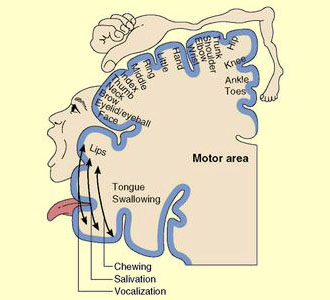From Thought To Deed
Published .

In 1870, Hitzig and Fritsch electrically stimulated various parts of a dog’s motor cortex. They observed that depending on what part of the cortex they stimulated, a different part of the body contracted. Then they found that if they destroyed this same small area of the cortex, the corresponding part of the body became paralyzed. This is how it was discovered that every part of the body has a particular region of the primary motor cortex that controls its movement.
But what is remarkable about this “motor map” is that certain parts of the body—those that can make the finest movements—take up much more space than others.

All of the body’s voluntary movements are controlled by the brain. One of the brain areas most involved in controlling these voluntary movements is the motor cortex. The motor cortex is located in the rear portion of the frontal lobe, just before the central sulcus (furrow) that separates the frontal lobe from the parietal lobe.
To carry out goal-directed movements, the motor cortex must first receive various kinds of information from the various lobes of the brain: information about the body’s position in space, from the the parietal lobe; about the goal to be attained and an appropriate strategy for attaining it, from the anterior portion of the frontal lobe; about memories of past strategies, from the temporal lobe; and so on.
The information processing that the brain must perform to initiate a voluntary movement can be divided into three steps. The first step is to select an appropriate response to the current situation, out of a repertoire of possible responses. This response, which corresponds to a particular behavioural objective, is determined in a global, symbolic fashion.
The second step is to plan the movement in physical terms. This step consists in defining the characteristics of the selected response as the sequence of muscle contractions required to carry it out.
The third step is to actually execute the movement. It is in this step that the motor neurons are activated that trigger the observable mechanics of the movement.
